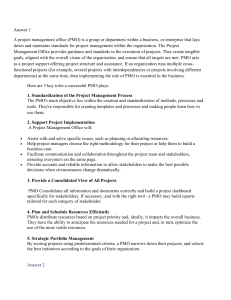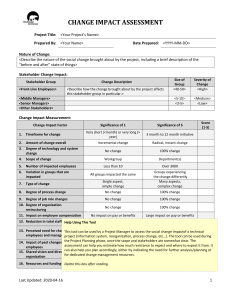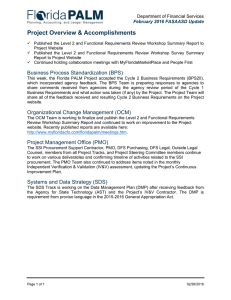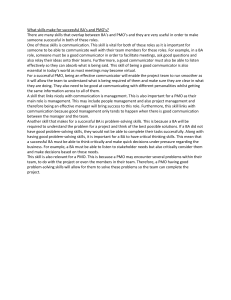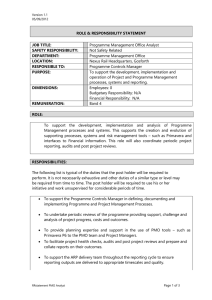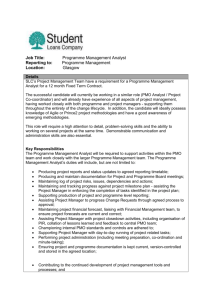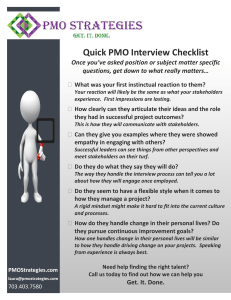PMO Functions in University Research Centers: A Research Paper
advertisement
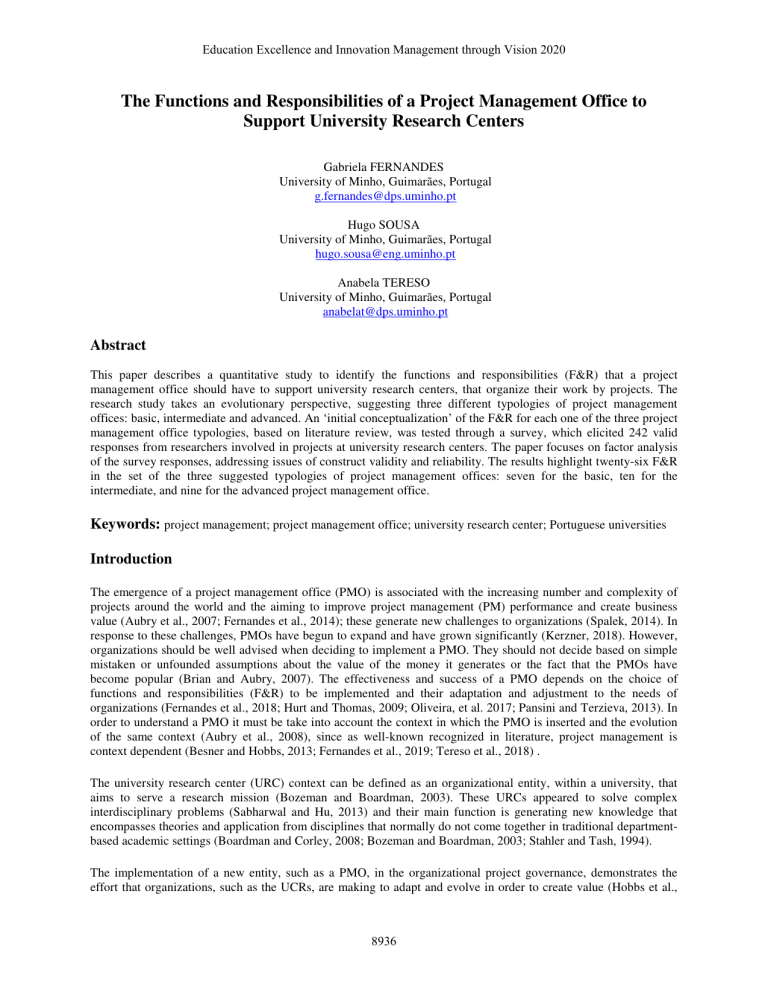
Education Excellence and Innovation Management through Vision 2020 The Functions and Responsibilities of a Project Management Office to Support University Research Centers Gabriela FERNANDES University of Minho, Guimarães, Portugal g.fernandes@dps.uminho.pt Hugo SOUSA University of Minho, Guimarães, Portugal hugo.sousa@eng.uminho.pt Anabela TERESO University of Minho, Guimarães, Portugal anabelat@dps.uminho.pt Abstract This paper describes a quantitative study to identify the functions and responsibilities (F&R) that a project management office should have to support university research centers, that organize their work by projects. The research study takes an evolutionary perspective, suggesting three different typologies of project management offices: basic, intermediate and advanced. An ‘initial conceptualization’ of the F&R for each one of the three project management office typologies, based on literature review, was tested through a survey, which elicited 242 valid responses from researchers involved in projects at university research centers. The paper focuses on factor analysis of the survey responses, addressing issues of construct validity and reliability. The results highlight twenty-six F&R in the set of the three suggested typologies of project management offices: seven for the basic, ten for the intermediate, and nine for the advanced project management office. Keywords: project management; project management office; university research center; Portuguese universities Introduction The emergence of a project management office (PMO) is associated with the increasing number and complexity of projects around the world and the aiming to improve project management (PM) performance and create business value (Aubry et al., 2007; Fernandes et al., 2014); these generate new challenges to organizations (Spalek, 2014). In response to these challenges, PMOs have begun to expand and have grown significantly (Kerzner, 2018). However, organizations should be well advised when deciding to implement a PMO. They should not decide based on simple mistaken or unfounded assumptions about the value of the money it generates or the fact that the PMOs have become popular (Brian and Aubry, 2007). The effectiveness and success of a PMO depends on the choice of functions and responsibilities (F&R) to be implemented and their adaptation and adjustment to the needs of organizations (Fernandes et al., 2018; Hurt and Thomas, 2009; Oliveira, et al. 2017; Pansini and Terzieva, 2013). In order to understand a PMO it must be take into account the context in which the PMO is inserted and the evolution of the same context (Aubry et al., 2008), since as well-known recognized in literature, project management is context dependent (Besner and Hobbs, 2013; Fernandes et al., 2019; Tereso et al., 2018) . The university research center (URC) context can be defined as an organizational entity, within a university, that aims to serve a research mission (Bozeman and Boardman, 2003). These URCs appeared to solve complex interdisciplinary problems (Sabharwal and Hu, 2013) and their main function is generating new knowledge that encompasses theories and application from disciplines that normally do not come together in traditional departmentbased academic settings (Boardman and Corley, 2008; Bozeman and Boardman, 2003; Stahler and Tash, 1994). The implementation of a new entity, such as a PMO, in the organizational project governance, demonstrates the effort that organizations, such as the UCRs, are making to adapt and evolve in order to create value (Hobbs et al., 8936 Education Excellence and Innovation Management through Vision 2020 2008). However, the implementation or reconfiguration of a PMO is an important organizational change. Usually this change is part of a broader organizational reconfiguration, which requires a methodology and an interpretive framework that can capture the complexity of organizational change (Aubry et al., 2010). For these reasons, the goal of this research is to study the main F&R that a PMO should have to improve the performance of PM in a URC. There is some academic research on PMO structures present in organizations as companies (Aubry et al., 2008; LeeKelley and Turner, 2017; Pellegrinelli and Garagna, 2009), however there is almost no information on the existence of PMO structures in URCs. Therefore, this paper aims to address the following research question: What are the main F&R that a PMO should have to support URCs? The research strategy adopted was a web-based questionnaire survey from researchers allocated to UCRs. The paper is structured in the following manner. First, a detailed literature review about different PMO typologies and F&Rs is provided, and based on the literature review, an ‘initial conceptualization’ of potential PMO F&R in UCR is presented, as a background. Second, the research method used for data collection and analysis is described. Third, the results from factor analysis and the ‘final conceptualization’ of the PMO structure based on the findings are presented and discussed. Finally, the paper concludes highlighting the research contribution and limitations, and the underlining paths for further research. Background PMO typologies PMOs are different in size and there can be just one or several PMOs in different places of an organizational structure, to support operational and/or strategic activities (Spalek et al., 2016; Tsaturyan and Müller, 2015). The complexity and variety of PMOs have evidently resulted in varieties of interpretations of what the PMO is and what it really should be (Pemsel and Wiewiora, 2013). Despite this, all definitions have a common feature, the objective of a PMO is to support PM and increase its effectiveness. Due to the different contextual dimensions of each organization, it is feasible to have different PMOs in structural and functional terms (Jalal and Koosha, 2015). Each organization should consider what role the PMO should play in the organization and adapt its functions to the needs to which the PMO must respond (Fernandes, et al. 2018). Therefore, when implementing a PMO, there is a need to adapt its structure, F&R to the organizational and strategic context, in order to increase the performance of the projects and to meet the different expectations (Cunha and Moura, 2014; Jalal and Koosha, 2014). The challenge for organizations is to reconcile the internal management of the projects with organization structures, so that PM is aligned with the strategic objectives of the organization (Too and Weaver, 2014). Several definitions and characteristics of a PMO were found in the literature. The various typologies found in the analyzed literature are presented in Table 1. The order in which they are presented takes into account the date of the recent, from the oldest to the most recent. The most recent reference is from PMI (2017), which presents three different PMOs: Supportive, Controlling, and Directive – with different levels of authority and control over the projects, respectively, low, moderate and high degree control. Different authors create different typologies with slight variations that they consider more appropriate. 8937 Education Excellence and Innovation Management through Vision 2020 Table 1: PMO typologies Types of PMOs References Desouza and Evaristo (2006) Singh et al. (2009) Kerzner (2009) Knowledge Manager Supporter Information Manager Light Heavy Functional Customer Group Corporate (Strategic) Type 2 Type 3 Controlling Coordinating Subordinate Coequal Balanced Basic Standard Advanced Crawford and CabanisType 1 Brewin (2011) Unger et al. Supporting (2012) Müller et al. Superordinate (2013) Hill (2013) Strategic Hubbard and Bolles (2015) Enterprise PMO Division PMO Aubry and Brunet (2016) Engineering and Construction Information Systems and Technology Business Processes PMI (2017) Supportive Controlling Directive Coach Business Unit Project PMO PMO Center of Excellence Project Office Project Support Organization Project Management Center of Excellence New Product/ Service Development PMO functions and responsibilities Taking into account the literature regarding the PMOs F&R, an ‘initial conceptualization’ of PMO was developed. Based on this particular context of UCR, a different PMO typology is proposed from those found in literature, with three types of PMOs: Basic, Intermediate and Advanced. The PMO conceptualization presents an evolutionary perspective, with functions attributed to each PMO type, implying that the PMO is supposed to evolve, not fixing itself as a Basic or Intermediate. The PMO ‘initial conceptualization’ to UCR is shown in Table 2, with the F&R assigned to each type, which served as the basis for the development of the web-based questionnaire conducted. What distinguishes one level from another is the growing importance of the PMO in the organization, a greater number of responsibilities and the position of the PMO at the organizational structure. Table 1: ‘Initial conceptualization’ of PMO F&R to URC Nº Basic FR1 FR2 FR3 PMO F&R Knowledge management: • Knowledge transfer • Increase knowledge about previous projects • Develop and manage files with project information Capture and spread good PM practices Provide well-trained project managers and teams (through training, workshops 8938 References Dai and Wells (2004); Desouza and Evaristo (2006); Pellegrinelli and Garagna (2009); Pemsel and Wiewiora (2013); Winter et al. (2006) Desouza and Evaristo (2006) Artto et al. (2011); Dai and Wells (2004); Desouza and Evaristo (2006); Education Excellence and Innovation Management through Vision 2020 Nº PMO F&R and seminars) FR4 FR5 Intermediate FR6 FR7 Provide periodic advice and guidance FR8 Monitor and control project performance FR9 Risk management FR10 Support decision-making process FR11 FR12 Advanced Promote social and informal interaction Develop methodologies (standards, procedures and tools) Build a knowledge platform: • Ensure the consult of lessons learned • Lessons learned repository Postproject evaluation services Supervision within the organization (monitor, summarize and report on project progress) Strategic management: • Ensure that the accepted projects are aligned with the organizational strategy • Align the needs of the project with those of the organization FR13 Evaluation and project selection FR14 Control and quality assurance Project financial management: • Monitor projects • Provide administrative support Close monitor and control of projects Human resource management: • Balancing skills • Ensure team cohesion FR15 FR16 FR17 FR18 References Kwak and Dai (2000); Pemsel and Wiewiora (2013); Singh et al. (2009) Pemsel and Wiewiora (2013) Cunha and Moura (2014); Desouza and Evaristo (2006); Kwak and Dai (2000) Cunha and Moura (2014); Desouza and Evaristo (2006); Kwak and Dai (2000) Cunha and Moura (2014); Desouza and Evaristo (2006); Kwak and Dai (2000) Cunha and Moura (2014); Desouza and Evaristo (2006); Kwak and Dai (2000) Dai and Wells (2004); Desouza and Evaristo (2006); Kwak and Dai (2000) Cunha and Moura (2014); Kwak and Dai (2000) Pellegrinelli and Garagna, (2009); Singh et al. (2009) Cunha and Moura (2014); Desouza and Evaristo (2006) Artto et al. (2011); Cunha and Moura (2014) Pemsel and Wiewiora (2013) Pemsel and Wiewiora (2013) Artto et al. (2011) Dai and Wells (2004); Müller et al. (2013); Pemsel and Wiewiora (2013) Dai and Wells (2004); Müller et al. (2013); Pemsel and Wiewiora (2013) Project portfolio management Research Method The literature on the conceptualization of PMOs in URC context is limited. Therefore, an exploratory research study in the subject was carried out. The first phase of the exploratory research consisted in the collection and analysis of the relevant literature in order to identify the PMO typologies and F&R commonly referenced by the most respected researchers in the area of PM (Table 2). Through the analysis of the proposed ‘initial conceptualization’ from literature review, twenty-five F&R were identified and used as the basis for conducting this research (Table 3). Therefore, the second phase consisted in the conduction of a questionnaire survey, which aimed to validate the ‘initial conceptualization’ of PMOs to support URC resultant from literature. The goal of the data analysis is to test and refine the ‘initial conceptualization’. 8939 Education Excellence and Innovation Management through Vision 2020 Data Collection An online questionnaire survey was conducted in Portugal, in order to validate the ‘initial conceptualization’ proposed. Respondents were asked to indicate the utility of each F&R of the PMO on a 5-point Likert scale where ‘5’ indicates ‘very high’ and ‘1’ indicates ‘very low’. The questionnaire was divided into three parts, as follows: • Part A – characteristics of the respondent. In order to understand the relationship of the respondents with their URC, respondents were asked for information about themselves, their experience and work context (e.g. type of URC, scientific area of research projects, roles at URC, experience, age, gender). • Part B – related to the PMO ‘initial conceptualization’ proposed. The question relates to identification of the utility, on a 5-point Likert scale, of the twenty-five identified F&R performed by a PMO (Table 3), for improving the performance of R&D projects developed at the URC. There is also an open question where respondents have the possibility of presenting any important F&R that was not included in the questionnaire. • Part C – In this part, the questions serve to test the consistency of the given answers in Part B. Table 3. Questionnaire structure PMO Survey/ type Item V1 Basic V2 V3 V4 V5 V6 V7 V8 Intermediate V9 V10 V11 V12 V13 V14 V15 PMO F&R Develop and manage repositories with past R&D project’s information (knowledge management) Ensure mentoring and coaching on the use of good project management practices by the principal investigator and her/his team Develop project management competences through training, workshops and seminars Promote social interaction, stimulating research communities/groups in order to strengthen the bonds of trust between the members of the research institution Ensure the cohesion of the team through a clear definition of the R&D projects’ objectives, as well as the research institution’s objectives Characterize the different types of R&D projects currently at the research institution (e.g., collaborative university-industry R&D projects) Develop and implement project management methodologies adjusted to each R&D project type Create a platform that provides the relevant information of all past and ongoing R&D projects Provide, through a platform, updated information about conferences in the different research areas, as well as potential partners for research Implement and manage a lessons learned database so they can be incorporated in new R&D projects Carry out specific project management tasks to support the principal investigator (e.g., project risk management, conduction of regular progress meetings with the R&D project team) Provide the principal investigator with a periodic report on the current state of the R&D project, particularly in terms of scope, time and cost (e.g. project cockpit chart) Implement and manage a risk database associated with different types of R&D projects Provide software tools to support project management Conduct post-project reviews to ensure the exploitation of the R&D 8940 Reference Table 2 FR1 FR2 FR3 FR4 FR4 FR5 FR5 FR6 FR6 FR6 FR7 FR8 FR9 FR10 FR11 Education Excellence and Innovation Management through Vision 2020 PMO Survey/ type Item V16 V17 V18 V19 Advanced V20 V21 V22 V23 V24 V25 PMO F&R project’s results (e.g., verify if the developed products have become commercialized products) Support the development of technical and financial reports to submit to the funding entity Participate in the strategic planning of the research institution, for the PMO to ensure the alignment of R&D projects with the research institution strategy Identify, select and prioritize the new ideas for R&D projects Ensure the quality of the different R&D projects’ management, through dashboards and audits Manage resource allocation between R&D project (resources capacity management) Seek funding for the development of R&D projects: networking and lobbying Conduct follow-up meetings with each R&D project team to ensure the management and project status update of the R&D projects at the research institution Manage the allocation of human resources to research, in particular identifying areas lacking or with excess human resources, i.e., balancing the research capacities Monitor and control the performance of R&D projects in order to report the status of the R&D projects portfolio to the research institution’s board Manage the exploitation of the results of each R&D project (e.g., knowledge and technology transfer, namely through university-industry interface units) Reference Table 2 FR11 FR12 FR13 FR14 FR15 FR15 FR16 FR17 FR18 FR18 The method of disclosure chosen was the online dissemination. The selection of the sample was made on the websites of three of the largest Portuguese universities – University of Coimbra, University of Porto and University of Minho and the studied population included PhD and non-PhD researchers collaborating with their UCRs. Nevertheless, it was verified through the obtained answers that although many researchers had their contacts associated with research centers of the universities identified above, they answered based on research centers of other universities, which increased the sample to nine Portuguese universities. Among the three universities were selected 122 research centers to disseminate the questionnaire, allowing to send the questionnaire via e-mail to 2856 potential respondents identified, were 242 answers were obtained resulting in 8.5% response rate. Data Analysis Data was analyzed using the SPSS software (Field, 2009). The reliability and validity of the data were tested using Cronbach’s alpha and factor analysis (FA), respectively. FA is conducted to explore the relation of the F&R of the PMOs with the concept of Basic, Intermediate and Advanced PMO, in other words, to verify if the results of the questionnaire led to the aggregation of the F&R resultant from the ‘initial conceptualization’ of Basic, Intermediate and Advanced PMO. In summary, it is intended to validate the proposal of the ‘initial conceptualization’ of the PMO for URC. Through factor analysis the measurable and observable variables can be reduced to fewer variables that share a common variance and are unobservable (Bartholomew et al., 2011), which are not directly measured. It is an essential method to simplify complex sets of data and analyze which variables ‘go together’ (Decoster, 1998). Findings and Discussion Completed questionnaires were received from 242 researchers. The universities with the highest participation were: University of Coimbra (31%), University of Minho (29%) and University of Porto (22%). Participation is concentrated in these three universities with 82% of the responses and the other six universities with 18% of participation. The respondents’ primary roles were: senior research fellow (43%), research fellow (26%); research 8941 Education Excellence and Innovation Management through Vision 2020 assistant (9%), research group coordinator (5%), board member (3%), director (2%), other: (2%). Note that 10% of the respondents indicated they performed more than one function. The respondents were mostly between 40-49 and 30-39 years old (34% and 33%, respectively). Regarding gender, there is no significant difference between male (53%) and female (47%). Concerning the respondents’ scientific areas, the most representative areas were “Exact Sciences and Engineering” and “Social Sciences and Humanities” with, respectively, 50% and 31%. Then “Life and Health Sciences” (11%) and “Natural and Environment Sciences” (8%). Most respondents (91%) believe that the establishment of a PMO structure would be useful for their URC and they were motivated to collaborate within the F&R of the PMO structure, which means that they perceived the value of a PMO in the URC to support their research work. Reliability Analysis Table 4 summarizes the FA steps followed in this research and their results. In order to simplify the interpretation of the results and to perceive which variables are part of each factor, the varimax rotation method was performed. Table 5 presents the varimax rotation and variance explained. Table 4: The FA steps followed and their results Steps Determine if FA is applicable to data set Determine number of ‘factors’ Develop ‘factor’ structure Results and Comments All items have at least half of more of their correlation >0.3 All data is suitable for FA KMO=0.942 The data set has the “excellent” level for FA (If KMO>0.9) Bartlett’s test of sphericity is significant (p≈0.000) The data is factorable All items have communalities above the threshold level (0.5) The data shows factorability Three ‘factors’ have an eigenvalue >1 explaining 70% of the total variance This is a 3-theme construct Using rotation results, obtain ‘factor’ loading matrix: FA#1: V15, 17, 18, 19, 20, 22, 23, 24, 25 FA#2: V7, 8, 9, 10, 11, 12, 14, 16, 21 FA#3: V1, 2, 3, 4, 5, 6, 13 Table 5. Varimax rotation and variance explained Item V1 V2 V3 V4 V5 V6 V7 V8 V9 V10 V11 V12 V13 FA#1 0.048 0.467 0.281 0.478 0.476 0.222 0.315 0.222 0.409 0.440 0.312 0.324 0.310 8942 FA#2 0.382 0.248 0.244 0.145 0.077 0.489 0.666 0.562 0.465 0.559 0.827 0.824 0.483 FA#3 0.698 0.609 0.708 0.679 0.731 0.586 0.439 0.536 0.416 0.457 0.172 0.198 0.501 Education Excellence and Innovation Management through Vision 2020 Item V14 V15 V16 V17 V18 V19 V20 V21 V22 V23 V24 V25 Eigenvalues Variance explained (%) FA#1 0.221 0.514 0.227 0.636 0.751 0.770 0.841 0.444 0.671 0.814 0.775 0.645 14.402 57.606 FA#2 0.760 0.391 0.839 0.348 0.233 0.293 0.266 0.532 0.295 0.217 0.363 0.320 1.824 7.295 FA#3 0.266 0.450 0.151 0.442 0.269 0.273 0.122 0.306 0.476 0.236 0.225 0.378 1.283 5.131 Taking in account the results obtained, it is determined that: • Factor 1: is constituted by nine variables, all strongly correlated positively: V15, V17, V18, V19, V20, V22, V23, V24 and V25. Therefore, this factor corresponds to Advanced PMO of the ‘initial conceptualization’. • Factor 2: is constituted by nine variables, all strongly correlated positively: V7, V8, V9, V10, V11, V12, V14, V16 and V21. Therefore, this factor corresponds to Intermediate PMO of the ‘initial conceptualization’. • Factor 3: is constituted by seven variables, all strongly correlated positively: V1, V2, V3, V4, V5, V6 and V13. Therefore, this factor corresponds to Basic PMO of the ‘initial conceptualization’. Once established the final structure of all factors, it is necessary to conduct reliability analysis, using Cronbach’s alpha analysis, presented in Table 6. Table 6. Cronbach’s alpha analysis ‘Factor’ in FA FA#1 Cronbach’s alpha 0.894 FA#2 FA#3 0.935 0.942 After performing the FA, it is possible to present a ‘final conceptualization’ of the proposed PMO F&R. The results suggest that some functions are better related to functions of other type of PMO, rather than what was initially proposed. In all, the results suggest the reallocation of four functions (see Table 7). Regarding to the V6 F&R, the result of its passage to the Basic PMO makes sense, since it is important to characterize, as soon as possible, the different types of R&D projects at the URC in order to develop all the PMO work according to these types of R&D projects. Regarding to the V13 F&R, this result is an indicative of the importance attributed to risk management, being widely recognized as one of the main PM knowledge areas. Therefore, this must be one of the F&R included in the Basic PMO. Regarding to the V15 F&R, the results indicate that it should be attached to Advanced PMO, as this F&R is associated to the more complex areas of management, such as the exploitation of benefits resulting from the projects. Finally, the V21 F&R, the results show that it should be attached to Intermediate PMO instead of Advanced PMO, emphasizing the importance of a PMO to support researchers in the search for funding, namely in 8943 Education Excellence and Innovation Management through Vision 2020 supporting the preparation of applications, as many of the respondents emphasized in the questionnaire open question (identify other F&R that the PMO should play). Table 7. Reallocation of F&R Survey/Item Initial conceptualization Final conceptualization V6 V13 V15 V21 Intermediate PMO Intermediate PMO Intermediate PMO Advanced PMO Basic PMO Basic PMO Advanced PMO Intermediate PMO In summary, from the questionnaire data analysis, the PMO ‘final conceptualization’ to support URC is composed by twenty-six F&R. This conceptualization aggregates all the functions of the questionnaire and also adds one new function (V26) ‘Support in the submission of applications for funding’, since 25% of the respondents who answered the open question perceived this F&R as useful. The function was placed in the Intermediate PMO closest to the function V16, because the two functions complement each other, since the submission of funding applications later requires the completion of technical and financial progress reports. Conclusions The main contribution of this paper is the identification of the main F&R of a PMO to support URCs, and getting evidence on the evolutionary perspective of the implementation of PMOs in organizations. First, the main F&R that a PMO should perform were identified from literature. Second, all these functions were adapted to the URC context and a PMO ‘initial conceptualization’ is proposed. Then, a web-based questionnaire survey was conducted were respondents were confronted with the perceived usefulness of the F&R identified in the PMO ‘initial conceptualization’ (see Table 3). Finally, through the analysis of the data collected from the questionnaire, it was possible to propose a PMO ‘final conceptualization’ to support URC. From FA it was possible to validate the PMO ‘final conceptualization’ proposed. Twenty-six F&R were proposed to be implemented in URC, divided by three PMO typologies with different levels: Basic, Intermediate and Advanced. This research also shows that respondents are receptive to the creation of a PMO in their URC and 93% of them did not consider it necessary to add more F&R to the proposed ‘initial conceptualization’. Nonetheless, a F&R that was strongly suggested by the respondents was the support to the submission of applications for funding, so that it has been included in the scope of an Intermediate PMO. The main limitation found in the development of this research was the lack of information in the literature regarding with the PMO from the perspective of the URC. All the literature that has been analyzed refers to the implementation of PMOs in a business context. Future research work can expand the scale of the survey to consolidate the research findings. Case studies will be very valuable, namely in understanding the weight that different URCs place on different F&R. The results of exploratory studies such as this require replication. Acknowledgements This research is sponsored by the Fundação para a Ciência e a Tecnologia FCT (SFRH/BPD/111033/2015), and by COMPETE: POCI-01-0145-FEDER-007043 and FCT – Fundação para a Ciência e Tecnologia within the Project Scope: UID/CEC/00319/2013. 8944 Education Excellence and Innovation Management through Vision 2020 References Artto, K., Kulvik, I., Poskela, J. and Turkulainen, V. (2011), 'The integrative role of the project management office in the front end of innovation,' International Journal of Project Management, 29(4), 408–421. Aubry, M. and Brunet, M. (2016), 'Organizational Design in Public Administration: Categorization of Project Management Offices,' Project Management Journal, 47(5), 107–129. Aubry, M., Hobbs, B. and Thuillier, D. (2007), 'A new framework for understanding organisational project management through the PMO,' International Journal of Project Management, 25(4), 328–336. Aubry, M., Hobbs, B. and Thuillier, D. (2008), 'Organisational project management: An historical approach to the study of PMOs,' International Journal of Project Management, 26(1), 38–43. Aubry, M., Müller, R., Hobbs, B. and Blomquist, T. (2010), 'Project management offices in transition,' International Journal of Project Management, 28(8), 766–778. Besner, C., and Hobbs, B. (2013), 'Contextualized Project Management Practice: A Cluster Analysis of Practices and Best Practices,' Project Management Journal, 44(1), 17-34. Bartholomew, D., Knott, M. and Moustaki, I. (2011), Latent variable models and factor analysis: a unified approach, Chichester, West Sussex: Wiley. Boardman, C. and Corley, E. (2008), 'University research centers and the composition of research collaborations,' 37, 900–913. Bozeman, B. and Boardman, C. (2003), 'Managing the New Multipurpose, Multidiscipline University Research Centers: institutional innovation in the academic community,' Transforming Organizations Series - IBM Center, 55. Brian, H. and Aubry, M. (2007), 'A Multi-Phase Research Program Investigating Project Management Offices (PMOs): The results of Phase 1,' Project Management Journal, 38(1), 74–86. Crawford, J. and Cabanis-Brewin, J. (2011), The Strategic Project Office, CRC Press. Cunha, J.A. and Moura, H. (2014), 'Project Management Office: The State of the Art Based on a Systematic Review,' Proceedings of the 10th ECMLG, 41–49. Dai, C.X. and Wells, W.G. (2004), 'An exploration of project management office features and their relationship to project performance,' International Journal of Project Management, 22(7), 523–532. Decoster, J. (1998), 'Overview of Factor Analysis,' Retrieved 04/28/2018 from http://www.stat-help.com/notes.html. Desouza, K.C. and Evaristo, J.R. (2006), 'Project management offices: A case of knowledge-based archetypes,' International Journal of Information Management, 26(5), 414–423. Fernandes, G., Ward, S., Araújo, M. (2014), 'Developing a Framework for Embedding Useful Project Management Improvement Initiatives in Organizations,' Project Management Journal, 45(4), 81–108. Fernandes, G., Pinto, E.B., Araújo, M., Machado, R. (2018), 'The roles of a Programme and Project Management Office to support collaborative university–industry R&D,' Total Quality Management & Business Excellence, 1-26 Fernandes, G., and Araújo, M. (2019), 'Improving and Embedding Project Management Practice: Generic or Context Dependent?' International Journal of Information Systems and Project Management, 7(1), 47-66. Field, A. (2009) Discovering statistics using SPSS. Los Angeles: Sage. Hill, G.M. (2013) The complete project management office handbook. Auerbach Publications. Hobbs, B., Aubry, M. and Thuillier, D. (2008), 'The project management office as an organisational innovation,' International Journal of Project Management, 26(5), 547–555. Hubbard, D.G. and Bolles, D.L. (2015), 'PMO Framework and PMO Models for Project Business Management,' PM World Journal, IV(I), 22. Hurt, M. and Thomas, J.L. (2009), 'Building Value Through Sustainable Project Management Offices,' Project Management JournalManagement, 40(1), 55–72. 8945 Education Excellence and Innovation Management through Vision 2020 Jalal, M. and Koosha, S. (2015), 'Identifying organizational variables affecting project management office characteristics and analyzing their correlations in the Iranian project-oriented organizations of the construction industry,' International Journal of Project Management, 33(2), 458–466. Kerzner, H. (2009), Project management: a systems approach to planning, scheduling, and controlling (11thedition), New Jersey. Kerzner, H. (2018), Project management best practices: achieving global excellence (4thedition), International Institute for Learning, New York. Kwak, Y. and Dai, C. (2000), 'Assessing the Value of Project Management Offices,' PMI Research Conference 2000, 1–8. Lee-Kelley, L. and Turner, N. (2017), 'PMO managers’ self-determined participation in a purposeful virtual community-of-practice,' International Journal of Project Management, 35(1), 64–77. Müller, R., Glückler, J. and Aubry, M. (2013), 'A Relational Typology of Project Management Offices,' Project Management Journal, 44(1), 59–76. Oliveira, C., Tereso A., and Fernandes G. (2017), 'PMO Conceptualization for Engineering and Construction Businesses,' Procedia Computer Science, 121, 592-599. Pansini, F. and Terzieva, M. (2013), 'Challenges and Benefits on the Path towards Discovering PMO: Cases from Italian Banking Sector,' Procedia Technology, 9, 627–637. Pellegrinelli, S. and Garagna, L. (2009), 'Towards a conceptualisation of PMOs as agents and subjects of change and renewal,' International Journal of Project Management, 27(7), 649–656. Pemsel, S. and Wiewiora, A. (2013), 'Project management office a knowledge broker in project-based organisations,' International Journal of Project Management, 31(1), 31–42. PMI (2017) A guide to the project management body of knowledge (PMBOK guide) (6th ed.). Newtown Square, Pa: Project Management Institute, Inc. Sabharwal, M. and Hu, Q. (2013), 'Participation in university-based research centers: Is it helping or hurting researchers?,' Research Policy, 42(6–7), 1301–1311. Singh, R., Keil, M. and Kasi, V. (2009), 'Identifying and overcoming the challenges of implementing a project management office,' European Journal of Information Systems, 18(5), 409–427. Spalek, S. (2014), Do You Really Want Your Project Management Office to Survive? Proceedings of PMI® Global Congress 2014, USA, Newtown Square: Project Management Institute. Spalek, S., Kuhn, T. and Dayton, S. (2016), Real-life examples of how to ensure PMO alignment with organisational needs, PMI® Global Congress 2016 - EMEA, Spain, Newtown Square: Project Management Institute. Stahler, G. and Tash, W. (1994), 'Centers and institutes in the reserach university: issues, problems and prospects,' Journal of Higher Education, 65(5), 540–554. Tereso, A., Ribeiro, P., Fernandes, G., Loureiro, I., and Ferreira M. (2018), 'Project Management Practices in Private Organizations,' Project Management Journal, 50(1), 1-17. Too, E.G. and Weaver, P. (2014), 'The management of project management: A conceptual framework for project governance,' International Journal of Project Management, 32(8), 1382–1394. Tsaturyan, T. and Müller, R. (2015), 'Integration and governance of multiple project management offices (PMOs) at large organizations,' International Journal of Project Management, 33(5), 1098–1110. Unger, B.N., Gemünden, H.G. and Aubry, M. (2012), 'The three roles of a project portfolio management office: Their impact on portfolio management execution and success,' International Journal of Project Management, 30(5), 608–620. Winter, M., Smith, C., Morris, P. and Cicmil, S. (2006), 'Directions for future research in project management: The main findings of a UK government-funded research network,' International Journal of Project Management, 24(8), 638–649. 8946

